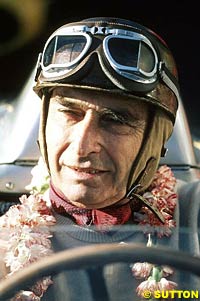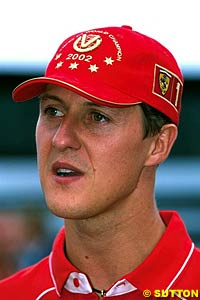
Atlas F1 Senior Writer
Just how similar - or different - are Michael Schumacher's accomplishment of five World Championship titles and the equal accomplishment of Juan Manuel Fangio? Atlas F1's Karl Ludvigsen, who wrote Fangio's biography, attempts to address this popular - and often controversial - topic
When racing resumed after World War II, Fangio despaired. He was sure his best years were behind him, racing despairingly across the pampas in the trucks he delivered to Argentina's far south. He'd only caught the racing bug at the age of 27, when he took part in a race that convinced him he would have a chance against some of the quickest men in Argentina. And his introduction to proper single-seaters was not made until after the war.
Could Fangio have won more titles in his day? He was very successful in his Argentine Auto Club Maseratis in 1949, but no world driver's title had yet been established. In 1950 he was a strong contender for the top ranking but was just beaten by Nino Farina. This was probably just as well, because he'd stirred up enough resentment in Italy as an Argentine barging into the nation's proud Alfa Romeo team. By 1951 people had come to know him better for his modesty, sincerity and awesome skill.
In 1952 he was knocked out of most of the season by a crash at Monza, and in 1953 Maserati just did not have the equipment to challenge Alberto Ascari's Ferrari. Fangio started 1954 with a known quantity in Maserati's new 250F, and might well have continued with them had Mercedes-Benz not succeeded in its lengthy wooing of the reluctant Fangio, whom Alfred Neubauer described as "shy as a maiden before her first kiss."
There, I think, is a similarity between Fangio at Mercedes and Schumacher at Ferrari. Both set measuring sticks for their teams that brooked no argument. Before each joined his respective team, his primacy among his contemporaries was not arguable. If the victories didn't come, it was clearly the fault of the cars, not the drivers. Mercedes was at sea otherwise. Karl Kling and Hans Herrmann both knew something about racing but were untested at the top of the game. This could not be said of Fangio, who did not hesitate to suggest improvements in the Stuttgart cars. He was especially unhappy with their brakes in 1954.
This is where these two great drivers are most alike. They both put intense and fruitful consideration into all aspects of their driving. Have you ever noticed the different goggles that Fangio wore? Do you think that's because he couldn't make up his mind? Not at all. He wore very small "welder's goggles" for races that were likely to be hot, as they exposed more of his face to the breeze. He wore the one-piece "tank goggles" when a track was likely to break up, because they were more resistant to fracturing by thrown stones. And he wore the classic goggles with an extra glass pane at each side for tracks such as Monaco where peripheral vision was more in demand.
Much has been made of Fangio's shrewd switching of teams, but he was also lucky, as he himself admitted. He might well have retired at the end of 1955 with three titles in his pocket, quitting when Mercedes-Benz did. He only went back to the track because his assets in Argentina were frozen after Peron's overthrow and he needed the dosh. Coincidentally Ferrari needed his services, so these former enemies became reluctant allies. Fangio went back to long-time friends Maserati for 1957. They promised him a winning car, and delivered, albeit at a cost that brought the company to its knees.
Could Fangio have booked another title in 1958, at the age of 47? I couldn't rule it out. Tony Vandervell was keen to see him drive his Vanwalls, which were surging to the fore. The Englishman even brought a spare car to Rouen in mid-season of 1957 for Fangio to try, but he politely demurred, saying that Stirling Moss was the team's rightful leader, a relationship with which he didn't want to interfere. Instead Fangio retired after some disappointing 1958 races in a 250F Maserati that was insufficiently improved. He admitted that at his age it was getting tougher to keep pace with the youngsters.
Of course Michael Schumacher missed some titles by small margins too. Seldom since he arrived in the game has a season passed that did not find him among the championship contenders. It took a disqualification in 1997 and a broken leg in 1999 to knock him out of the top racing ranks. Just as Fangio did in his day, Michael sets the standard for excellence in his. In this most important respect they are much alike.
This is the first chance I've had to reflect on the achievement of Michael Schumacher in equaling the five World Championships of Juan Manuel Fangio. As one of Fangio's biographers I guess I'm as qualified as anyone to consider what parallels - if any - there may be between these two great careers.
 First we have to address the incredible disparity in age. Michael is 33 this year - still very much in his prime, one might say. With the right equipment he could win two or three more titles, and I expect him to. But then consider Fangio. During the first-ever year of the World Championship, 1950, he turned 39! He was 40 when he won his first title in 1951 and 46 in 1957, when he shrugged off striplings like Stirling Moss, Peter Collins and Mike Hawthorn to win his fifth world crown.
First we have to address the incredible disparity in age. Michael is 33 this year - still very much in his prime, one might say. With the right equipment he could win two or three more titles, and I expect him to. But then consider Fangio. During the first-ever year of the World Championship, 1950, he turned 39! He was 40 when he won his first title in 1951 and 46 in 1957, when he shrugged off striplings like Stirling Moss, Peter Collins and Mike Hawthorn to win his fifth world crown.
 Schumacher set similar standards for Ferrari. Too much has been made, I think, of his supposed role in "building the team". Jean Todt built the team, backed by Luca di Montezemolo. But they always had a way to judge their success in creating a competitive car: they could find out whether Michael could win with it. There was and is simply no doubt about his exceptional adeptness in both speed and strategy.
Schumacher set similar standards for Ferrari. Too much has been made, I think, of his supposed role in "building the team". Jean Todt built the team, backed by Luca di Montezemolo. But they always had a way to judge their success in creating a competitive car: they could find out whether Michael could win with it. There was and is simply no doubt about his exceptional adeptness in both speed and strategy.
Please Contact Us for permission to republish this or any other material from Atlas F1.
|
Volume 8, Issue 32
Atlas F1 Exclusive
Absolute Domination, Part I: The Champion
Absolute Domination, Part II: The Races
Absolute Domination, Part III: Patrick Head
Atlas F1 Special
Ground Supremacy
Measuring the Quintuple Champs
Articles
View from the Paddock
Columns
Rear View Mirror
Elsewhere in Racing
The Weekly Grapevine
> Homepage |